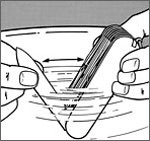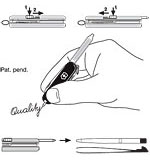Victorinox Swiss Army Knives
Info

(History) (Steelinfo) (Care)
Charles Elsener
, the
fourth son of the hatmaker Balthasar Elsener-Ott decided to become a cutler. At
the age of 24, after his journeyman's years in the South German district of
Tuttlingen, he returned to his home and in 1884 opened his
own business in Ibach near Schwyz in Switzerland. In those days there
was hardly any industry in the district of Schwyz, and many of the young farmers
were compelled to emigrate to North America, Australia or New Zealand. In order
to create new employment opportunities, Karl Elsener took the initiative in 1891
to form the Swiss Cutlery Guild with the main aim of producing the soldiers'
knives which the Swiss Army had up to that time purchased from Solingen in
Germany. In October 1891 the first delivery to the Swiss Army was made.
Thereafter Karl Elsener began producing other ingenious pocket knives which he
did not identify with numbers but with names, such as Student knife, Cadet knife
and Farmer's knife. The Soldier's knife was very robust and also relatively
heavy. Because of this, Karl Elsener developed specifically for the officers a
lighter and more elegant knife which, apart from the blade, awl, can opener and
screwdriver on the Soldier's knife, also had a second small blade and a
corkscrew. This new model with only two springs for the six blades he called the
"Officer's knife". Its design was officially registered on June 12th 1897. Swiss
officers do not receive their knives from the Army as the recruits do, but many
of them purchase them privately at cutlery shops where the simple Soldier's
knife is also available.
This handy multi-purpose pocket knife very soon became
most popular. More and more orders started flowing in from abroad. Soon, further
tools were added to the knife, for example a wood saw and scissors. Later on, a
bottle opener was added to the large screwdriver, the can opener was improved
and had a small screwdriver added. Subsequently a nailfile was added, toothpick
and tweezers, metal saw with metal file, fish scaler with hook disgorger and
ruler, Phillips screwdriver, a key ring and a magnifying glass. Today this
Officer's knife is available in over 100 different combinations. The flagship of
the assortment is the "SwissChamp"
model with 31 different features. All this in a toolbox which only weighs 185
grams (6.5 ounces) and can be held comfortably in your hand. The New York Museum
of Modern Art and the "Staatliches Museum für angewandte Kunst" in Munich have
selected the VICTORINOX "Champion" for their collection of "Good Industrial
Designs". The "SwissChamp" is made up of 64 separate parts and has over 450
processes in its production.
In 1909, after the death of his mother, grandfather
Elsener chose her Christian name VICTORIA as his trade-mark. Only in 1921 did
the invention of stainless steel take place. Subsequently in Ibach, when
stainless steel knives were made, the word INOX was added to VICTORIA, and out
of these two words the present-day trade-mark VICTORINOX was created.
Today (2009) Victorinox has a global workforce of over 1,700 and generates sales
of about 500m Swiss francs.
In the years 1945-1949 VICTORINOX pocket knives were sold
in large quantities to the PX shops of the US Army, Navy and Air Force. It is
largely due to these deliveries that the Swiss knife became so well known
throughout the world. For American officers and soldiers the word
"Offiziersmesser" was too difficult and tongue twisting, so they simply called
it "Swiss Army Knife". Today this name is well known throughout the whole of the
English speaking world. In France it is known as the "Couteau Suisse" and in
Germany and Austria as the "Schweizer Messer", whitch also mean "Swiss Knive".
Lyndon B. Johnson, President of the United States,
presented 4,000 pocket knives engraved with his initials to his guests at the
White House. Subsequently, Presidents Ronald Reagan and George Bush followed the
same tradition. Swiss diplomats and senior army officers often present their
hosts in other countries with the Swiss Officer's knife. The knife has special
appeal for pilots. When Francis Gary Powers, the pilot of the American U2
observation plane, was shot down over Russia in 1960, the Russians publicised
all the secret items which were found on him, amongst them the famous small red
knife. The Nigerian Air Force ordered a large quantity with the addition of a
curved blade. When all seems lost one can use it to cut through a knotted
parachute line. As from 1976 the German Army has also been supplied with its
"Army knife" by VICTORINOX in Ibach. In place of the Swiss cross, however, the
German eagle is featured on the olive-green casing of this knife.
The American Space Administration NASA has also ordered
the "Swiss Army Knife" as standard equipment for its "Columbia" space shuttle
program. The universal success of the VICTORINOX pocket knives is largely due to
their quality and price. They represent good value for money and function
extremely well. They are sold in more than 100 countries. The largest customers
are the United States and surprisingly enough Germany where, although they have
a very large home production, the Swiss cross is recognised as a seal of
quality. The "Swiss Army Knife" is being constantly copied abroad, e.g. in
Germany, France, Spain, USA, Japan, China, etc., but the original quality has
never been equalled. Unfortunately, however, on some of the foreign imitations
the Swiss cross was added, which could be stopped thanks to the intervention of
Swiss embassies and court orders. The application of the Swiss Cross was
undertaken in order to confuse the public and give the impression that they were
dealing with a genuine Swiss product. The official ruling, however, gives only
the two Swiss manufacturers, VICTORINOX and WENGER, the right to use the Swiss
cross on their knives.
During recent years VICTORINOX pocket knives have
increasingly found their way into the promotional market. They are reckoned
amongst the most popular and successful
promotional gifts.

 (History) (Steelinfo)
(Care)
(History) (Steelinfo)
(Care)
After a sophisticated hardening process at 1040°C and an
annealing temperature of 160°C the blades achieve a hardness of RC 56.
| Material |
for |
Shortname |
C (%) |
Cr (%) |
Mo (%) |
V (%) |
| 1.4110 |
Blade |
X55CrMo14 |
0,48 - 0,6 |
13 - 15 |
0,5 - 0,8 |
< 0,15 |
| 1.4021 |
Spring |
X20Cr13 |
0,16 - 0,25 |
12 - 14 |
|
|
| 1.4031 |
Tool |
X39Cr13 |
0,36 - 0,42 |
12,5 - 14,5 |
|
|
What does stainless mean?
Stainless steel has a high resistant to corrosion. The steel is tempered,
annealed and polished to achieve the necessary hardness and provide optimum
resistance to corrosion.
If stainless steel products are not cleaned over a long period of time,
aggressive substances (fruit acids, salt water etc.) are able to act on
(corrode) the material.
The spring exerts a pressure of 12 kilograms on the large
blade and 8 kilograms on the small blade. The combined 20 kilograms exert
pressure on the corkscrew. With two springs and six pressure locations a total
of 70 kilograms pressure is achieved. To close the blades high pressure is
necessary since the ratio of the pressure points between the axis and the
thumbnail recess is 1 to 20. In the case of the "SwissChamp" model with 8
springs and 24 pressure points a total of 300 kilograms (660 lb) is achieved.

 (History) (Steelinfo)
(Care)
(History) (Steelinfo)
(Care)
Care preservation
 |
|
Care
When cutting or peeling fruit, fruit juice
often runs down between the blades, sticking them together once it
has dried. Open and close the blades in warm water several times and
the tools can be easily moved again. When they have dried it would
be good, but not always necessary, to apply a small drop of oil
between the blade or tool shank and the spring. On the locking
mechanism sometimes a drop of this excellent gliding oil could be
helpful. Do not put penknives or other multi-tools in the
dishwasher! |
 |
|
When selecting knife oil, various properties
need to be taken into account, including the legal provisions
relating to the safety of foodstuffs. Some oils intended for pocket
knives do not provide satisfactory lubrication or may even prevent
the knife working properly (causing it to stick, for example).
Our recommendation
Multi Tool Oil (Victorinox Art. No.: 4.3301)
The main features of this multi-purpose oil are: neutral odour and
taste, highly resistant to ageing, good wear and corrosion
protection qualities, suitable for use with foodstuffs |
 |
|
Sharpening
Re-sharpen using a whetstone at an angle of
15° - 20°. This will result in a cutting angle of 30° - 40°. If
sharpening on a grinding wheel, always cool with plenty of water to
avoid excessive temperatures. |
 |
|
Handy Ballpoint Pen
First press button towards blades, then slide
forward or backward. To write, open nailfile as extension.
To replace, simply pull out empty ballpoint
and click new one into place. Enclosed toothpick can be replaced
with tweezers. |
(History) (Steelinfo) (Care)
Info by Victorinox
www.pizzini.at



